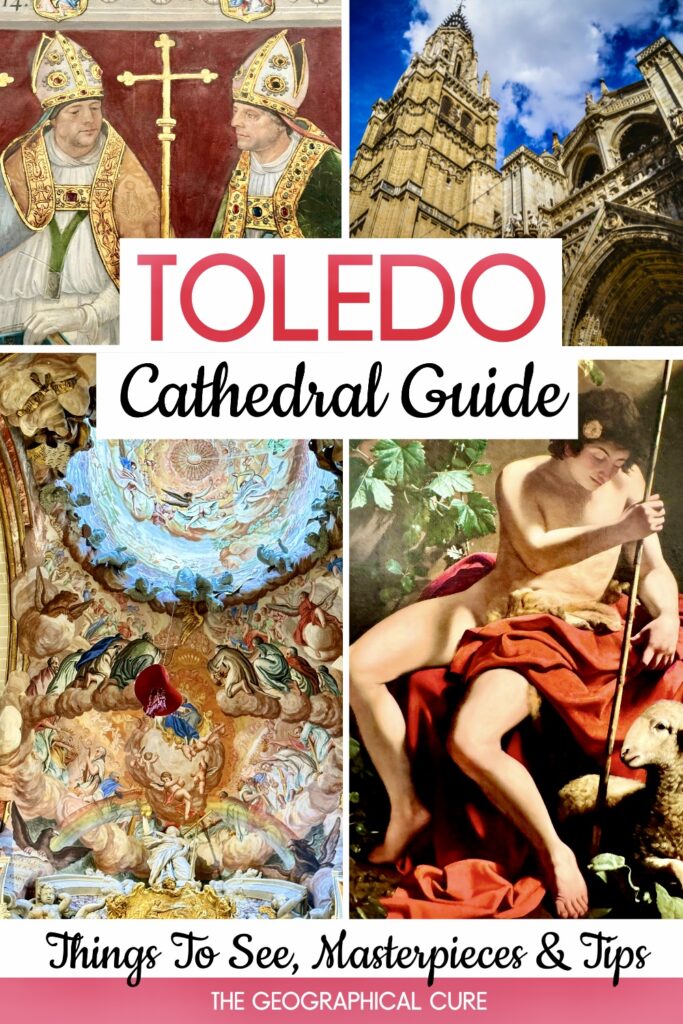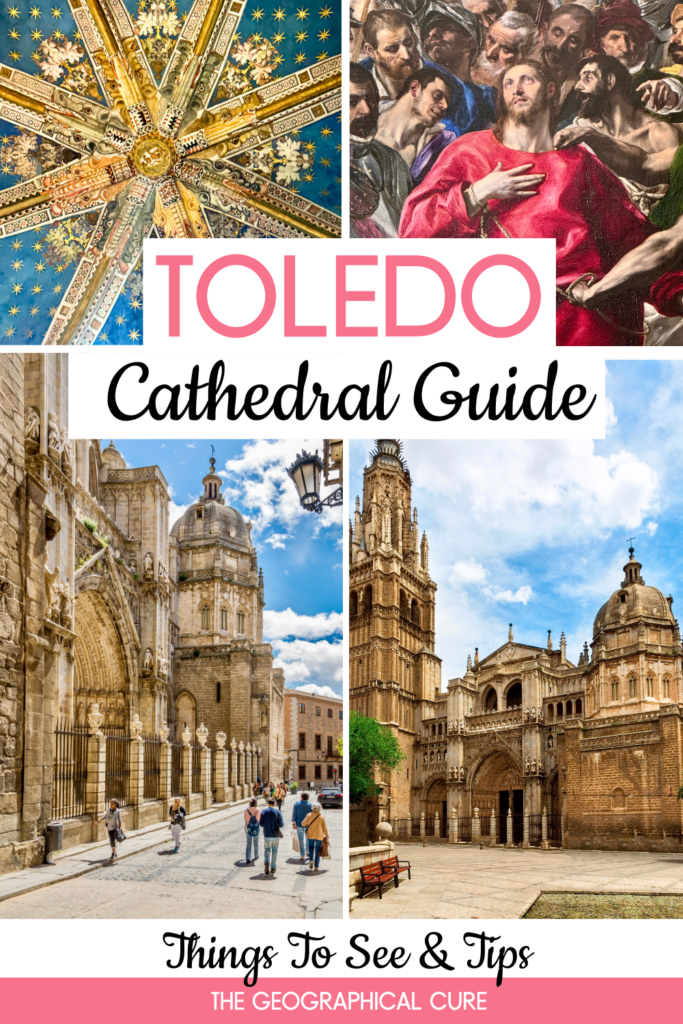Holy Toledo, does the city of Toledo have a magnificent cathedral! I was bowled over, and I’ve seen some amazing cathedrals in my day.
The cathedral is considered the spiritual heart of Spain. Construction began in 1226 during the reign of King Ferdinand III.
The building was commissioned by Archbishop Rodrigo Jimenez de Rada. He studied theology in Paris where he became familiar with Notre Dame.
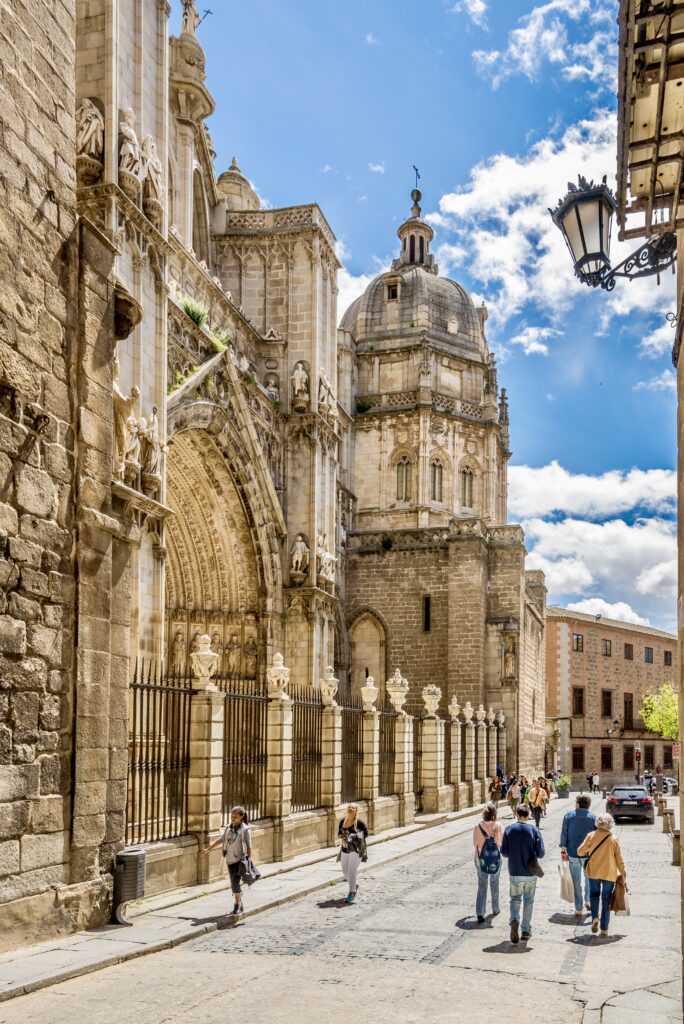
He hired a French architect to design a church that would rival Notre Dame in size and beauty, to become a symbol of the power of the Spanish Catholic church.
Over the centuries, the cathedral was decorated with the sites you will see on a visit — a massive Gothic altarpiece, Renaissance frescos, a masterpiece-filled sacristy, a golden monstrance, 25 chapels, and a one-of-kind skylight.
>>> Click here to book a guided tour of the cathedral
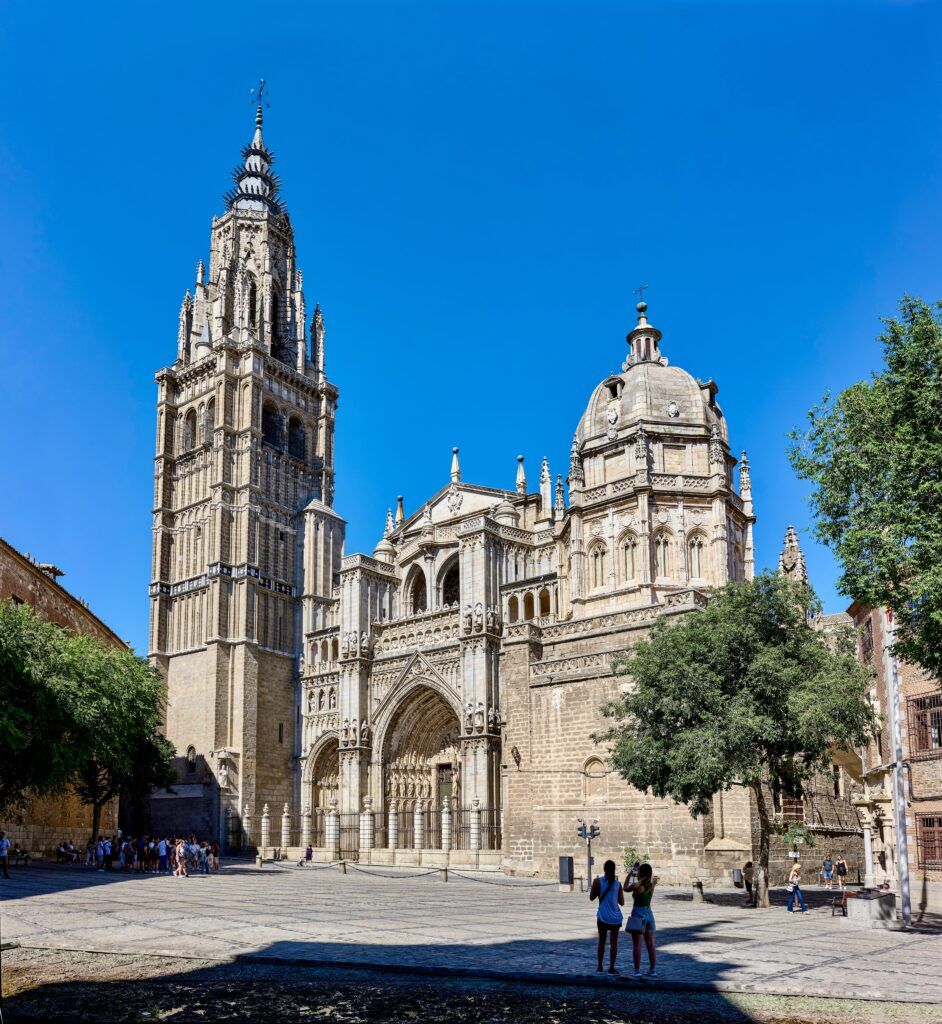
Guide To Toledo Cathedral: What To See
Here are the cathedral’s must see highlights. I’ve listed them in the order it makes sense to visit them after entering the cathedral.
Facade
The facade of the cathedral is mainly Gothic. Though not all Gothic. To be truly Gothic, it would need matching spires.
But it only has one. The right side was never completed. Instead, when it was growing unstable, the son of El Greco topped it with a Baroque dome.
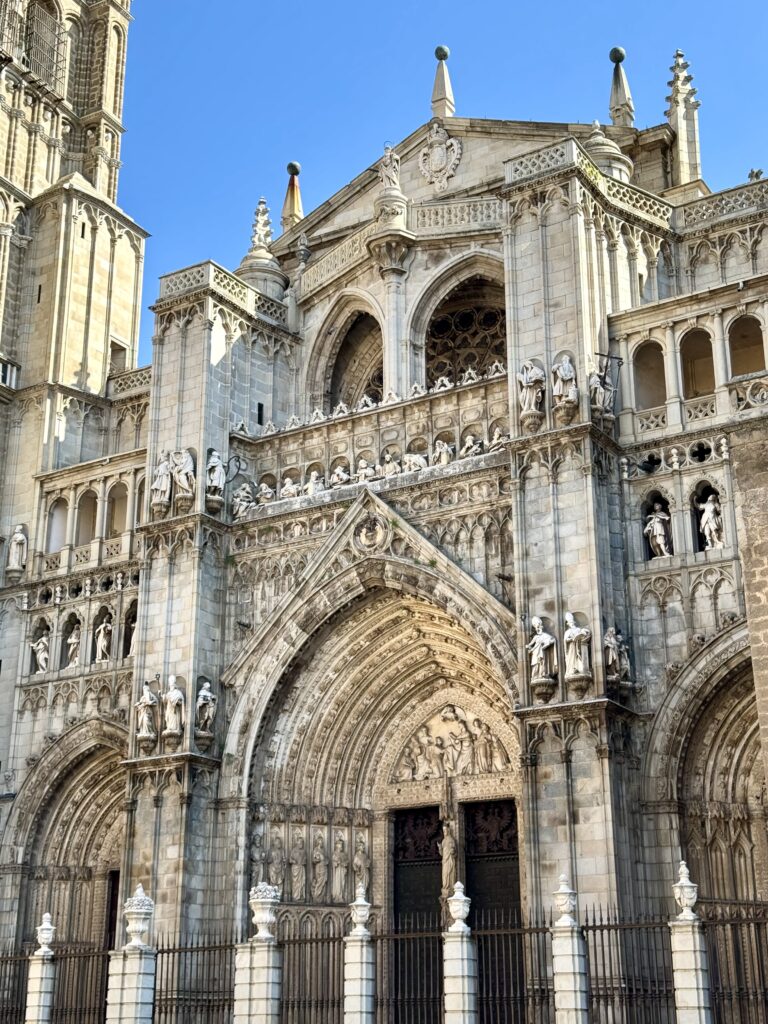
There are three elaborate portals, known as the Gate of Forgiveness, the Gate of Judgment, and the Gate of Hell.
The central portal is the Gate of Forgiveness. It was named for the indulgences granted to those who crossed it. Today, the door is only opened no special occasions for royalty or the pope.
The portals are made of soft yellow limestone. The rest of the cathedral was constructed with gray granite.
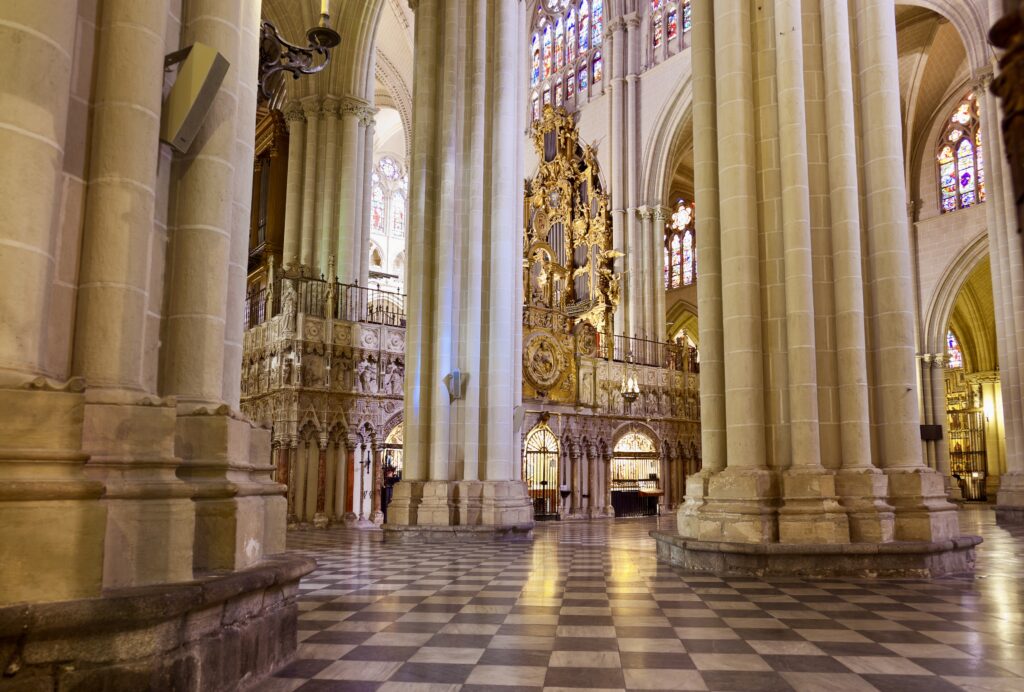
Nave
The cathedral interior is Spain’s purest form of Gothic architecture. The nave is over 400 feet long and 200 feet wide. It’s made up of five aisles.
It doesn’t seem quite that long when you first walk in. But that’s because the choir is smack in the middle of the nave.
You’ll find a soaring ribbed vaulted ceiling, 500 year old stained glass windows, ornate wood carvings, statuary, and a forest of stout pillars.
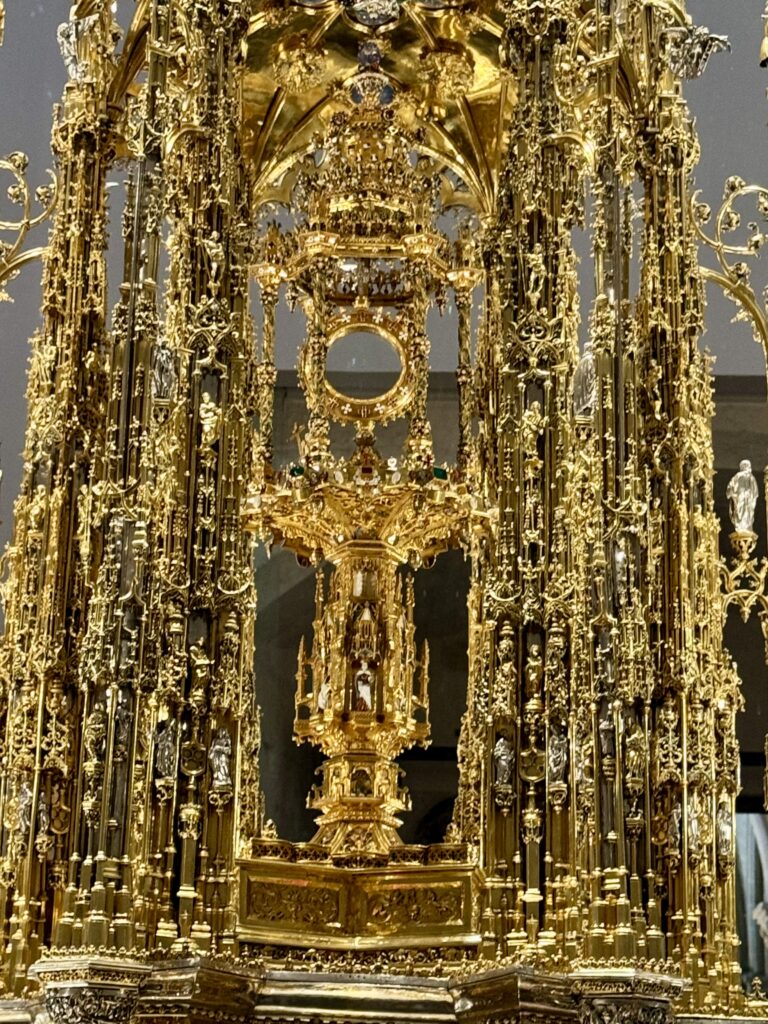
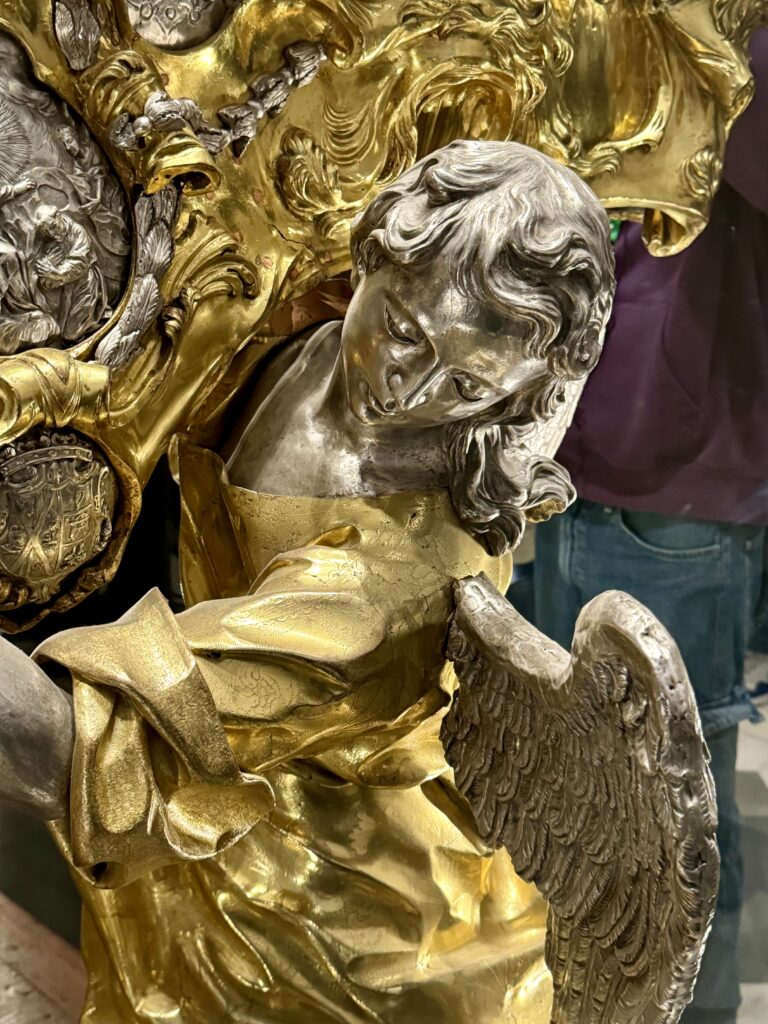
Treasury: Monstrance
The Chapel of the Treasury is a small room located at the base of the bell tower. In the center, you’ll see the star attraction, the Monstrance of Corpus Christi (body of Christ).
The monstrance is a 500 pound, 10 foot Gothic tower. It’s gilded with gold, silver, and precious stones. There are 500 pieces to it, including 250 mini statuettes.
It’s the most important thing in the cathedral. It was made for Queen Isabella and purchased by the cathedral.
The monstrance that holds the host is a smaller portable piece within the shrine. It was designed to hold the Holy Communion wafer.
The monstrance is paraded around town every year during Toledo’s most beloved festival, The Corpus Christi Festival.
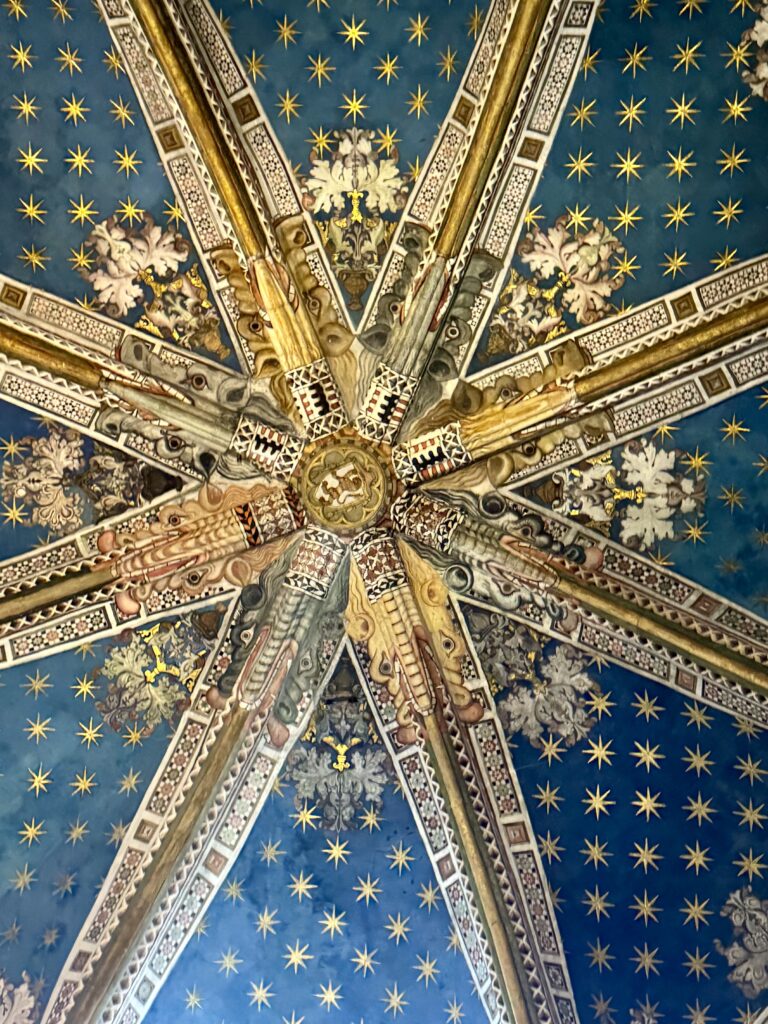
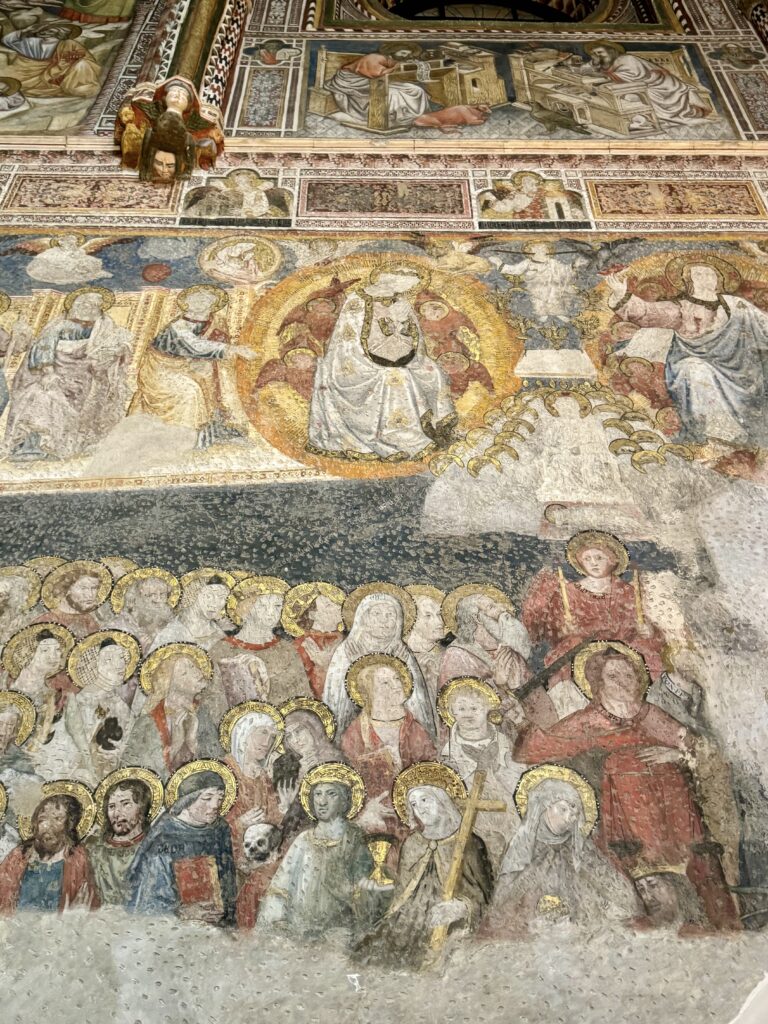
Cloister
After the treasury, take the door immediately to the left to enter the cloister. It’s worth a visit for its frescos and finely carved colonnade.
The cloister houses late 18th century frescos depicting the life of St. Eugene, the city’s patron saint and the founder of the Toledo Holy See.
The most important thing to see here is the Chapel of San Blas, one of the most beautiful chapels in the cathedral.
It contains a splendid fresco cycle by the Florentine painter Starnina from the second half of the 14th century. Starnina was a pupil of the Italian Renaissance master Giotto.
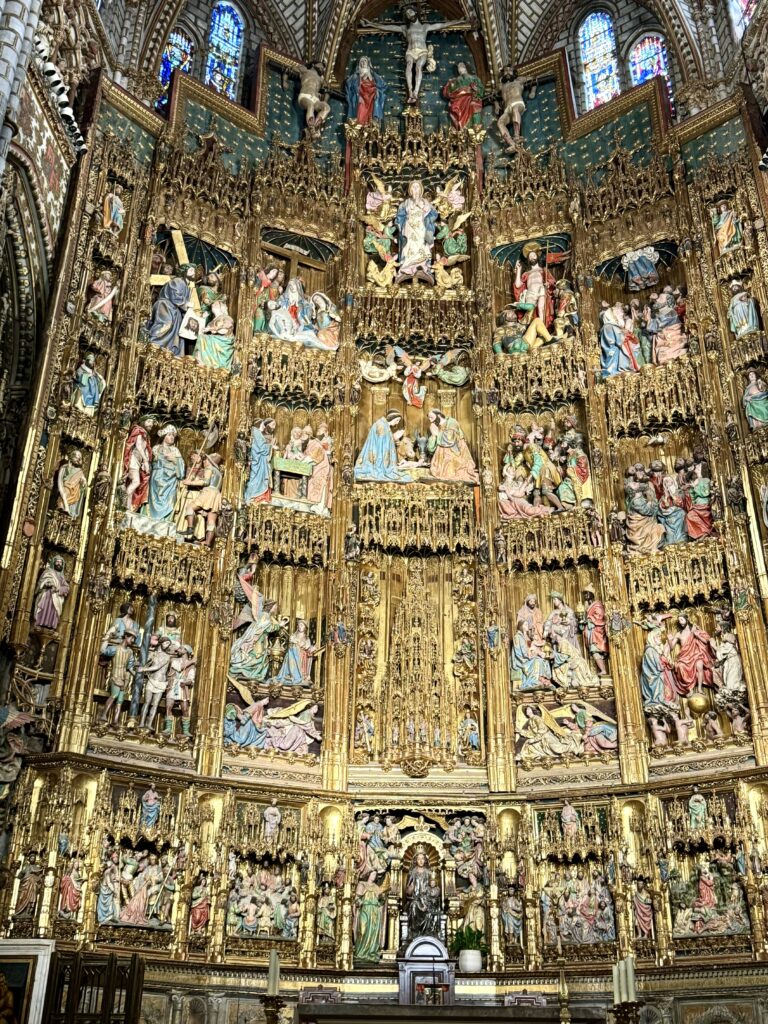
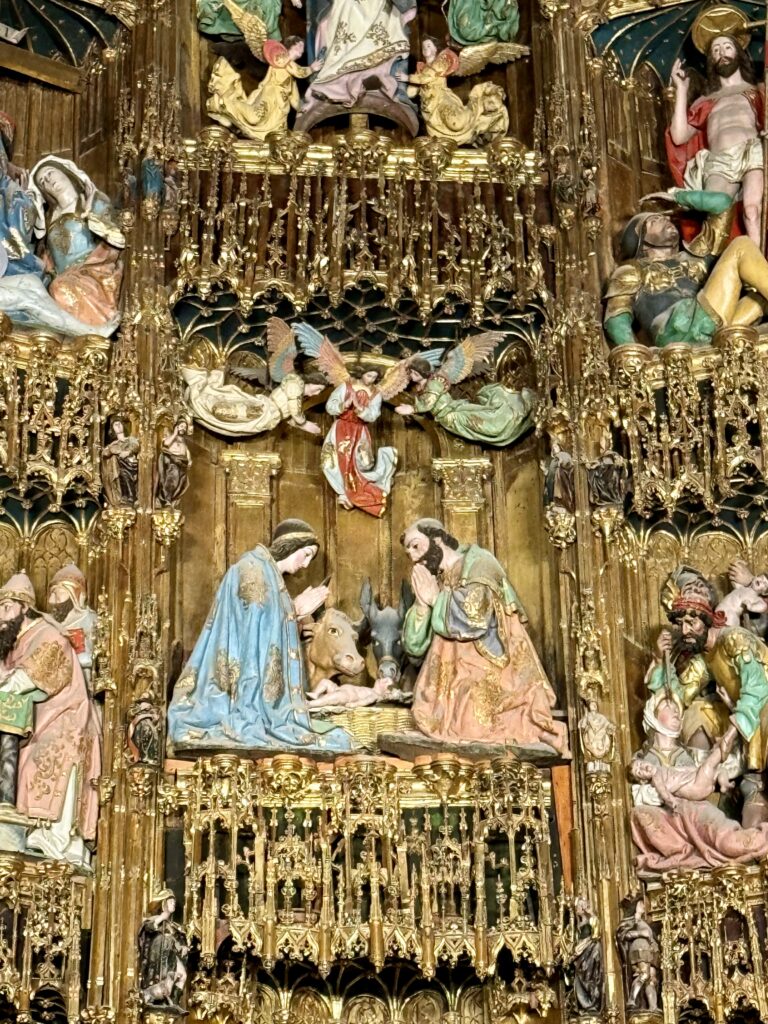
Main Chapel & High Altar
The main chapel is the most sacred part of the Toledo Cathedral. Climb up two steps and grip the iron grill to peer inside. This is where mass is held on Sunday morning.
The grill is a wonderful Renaissance piece by Francisco de Villapando from 1548, considered the best in Spain. It’s made of bronze and brass and plated in gold and silver, though some of the luster has worn off over time.
The altar is one of Spain’s best pieces of Gothic art. It’s a stunning 80 feet high piece made of real gold on wood.
The scenes narrate the life of Jesus, from the annunciation to the resurrection.
To the right of the altar are a row of stone statues of bishops and saints. To the left is the tomb of Cardinal Mendoza, the man who helped Ferdinand and Isabella conquer the Moors and promoted Christopher Columbus.
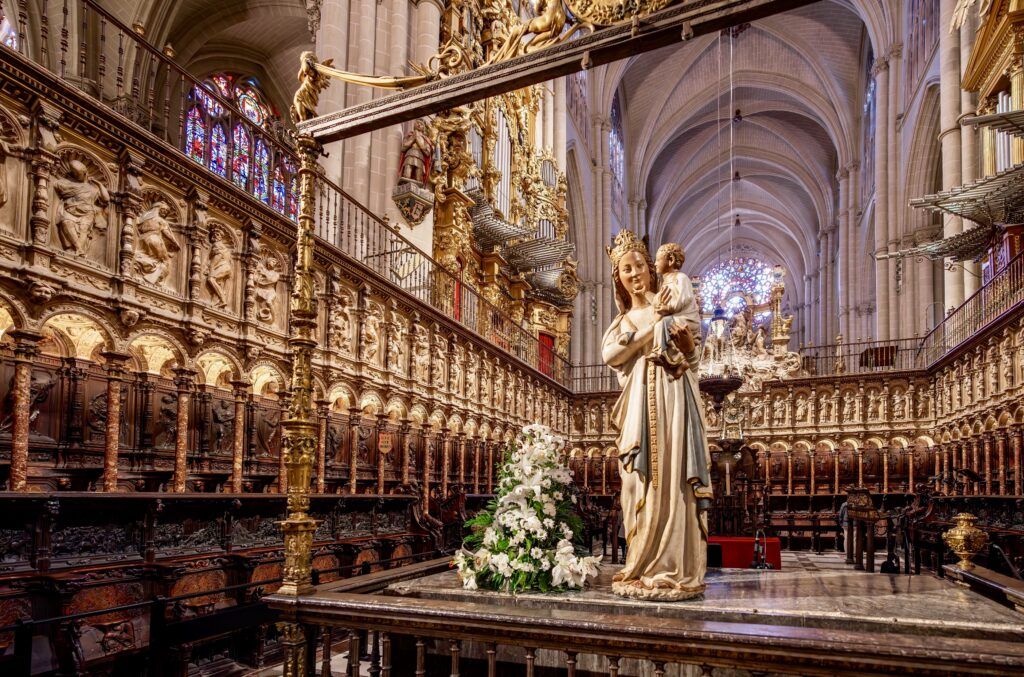
Choir
The gorgeous choir was one of my favorite spaces in the cathedral. You’re greeted by a sculpture of the Virgin Mary called the Virgin Blanca.
The intimate space is lined with 120 wood carved stalls. The carvings depict scenes from the Christian Reconquista, specifically the retaking of Granada which marked the end of the 800 year holy war against Muslims.
The seat backs are made of carved walnut and feature New Testament figures. The misericords, or “cheat seats,” allowed tired worshippers to lean back while they stood.
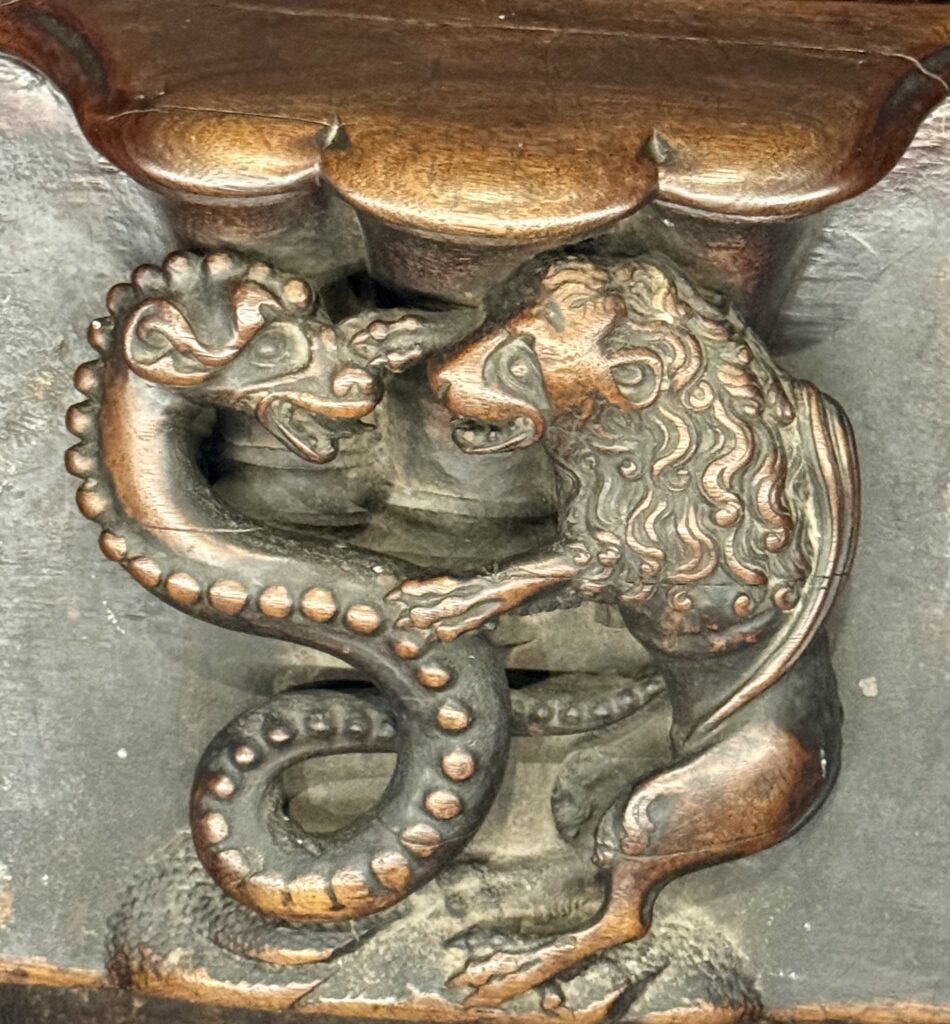
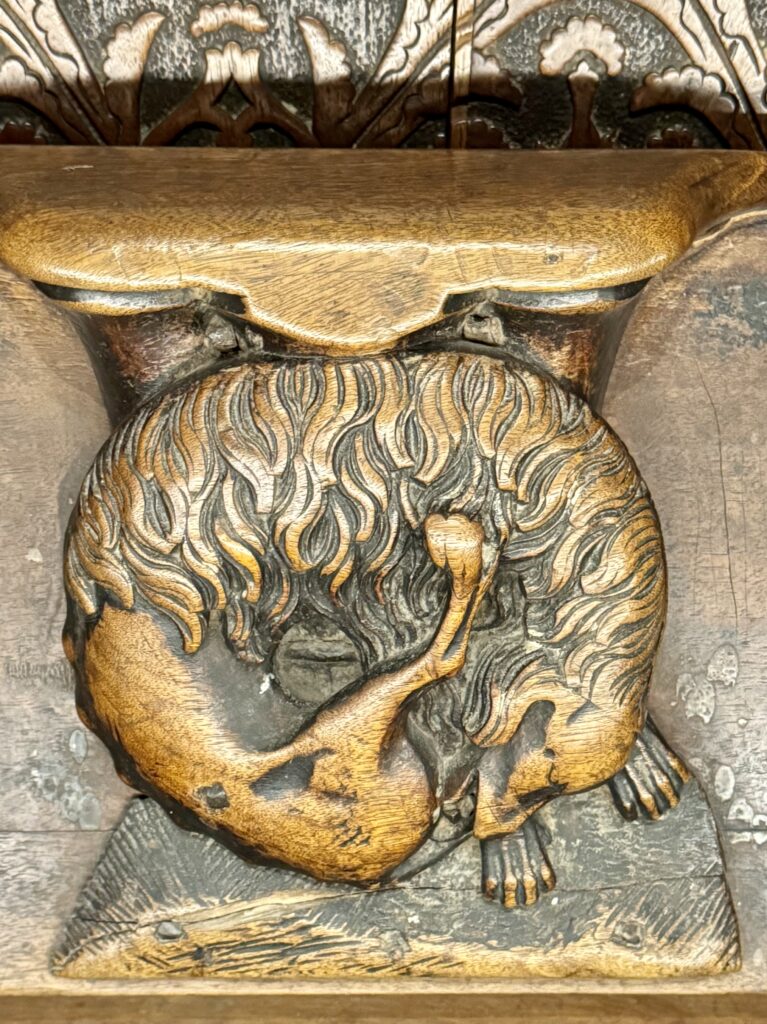
They’re decorated with cute little animals (even erotic scenes!) representing the vices and virtues of mankind.
The choir is also ringed with alabaster stone statues giving you a genealogy of Christ.
And there are two fine organs, each with over 600 pipes. One is Baroque and the other is Neoclassical.
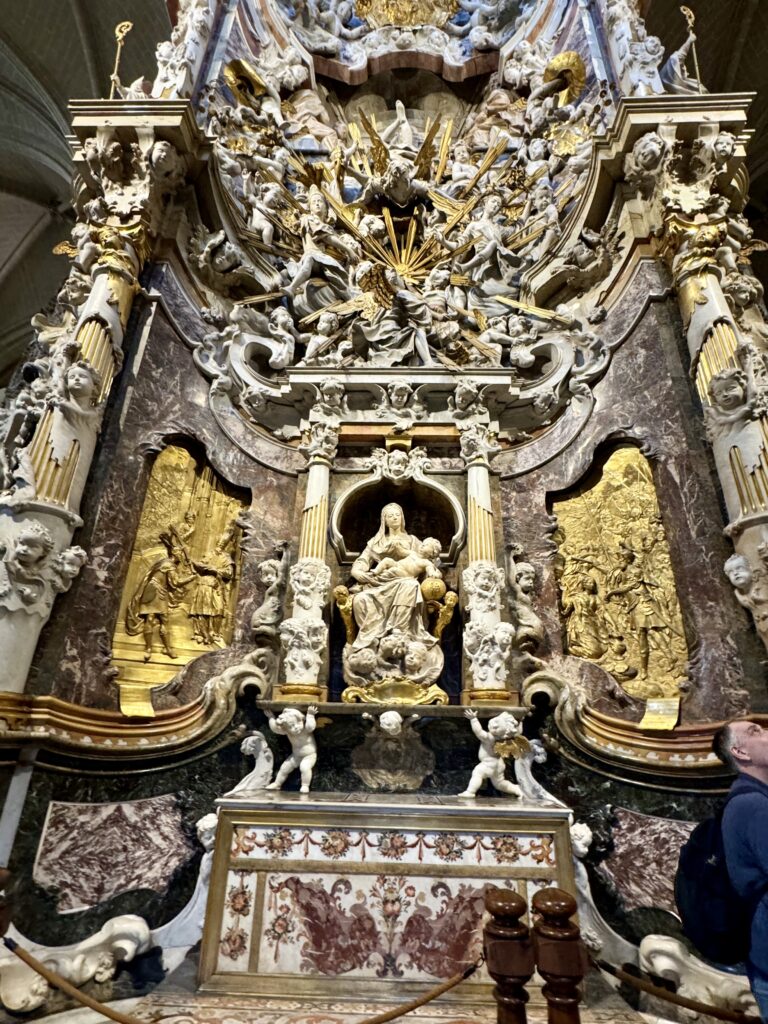
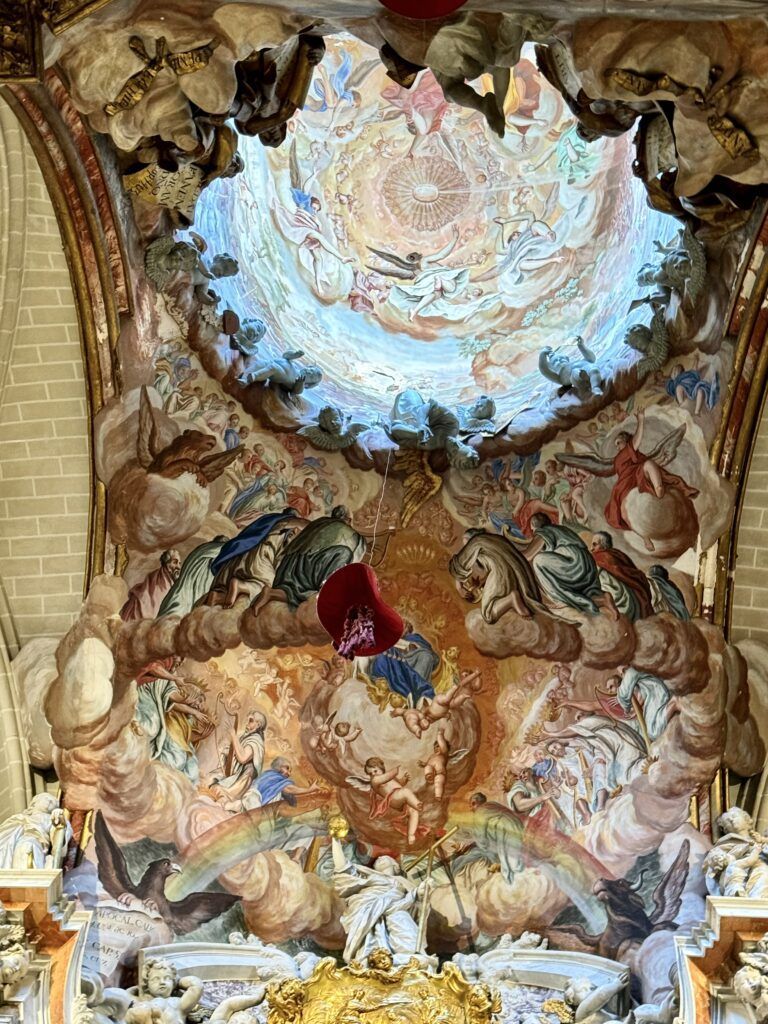
El Transparente
After you pass the main chapel, you will arrive at the cathedral’s Baroque folly, El Transparente. It’s a towering white, red, and gold altarpiece bursting with statuary. This multimedia masterpiece was created by the sculptor Narciso Tome in 1732.
In the 1700s, a skylight was cut in the cathedral ceiling. There are two windows.
The window at the high part of the vault lets in the morning light, sending a beam to light up the sculpture. You can see depictions of prophets in the dome frescos and scenes linked to the Eucharistic the Old Testament.
The second window is at the back of the main chapel. This is where you can see the dynamic marble altarpiece. It shows characters and scenes of the Eucharist from the New Testament.
The altar itself is a monumental structure adorned with marble columns, gilded decorations, and elaborate reliefs.
There’s a riot of angels and cherubs. Baby Jesus points a finger at original sin. At the top is the Last Supper, the climax of the piece.
Chapter House
The Chapter house is directly behind the main chapel on the right. It was built in the early 16th century by Cardinal Cisneros and was used as a meeting hall.
The hall is decorated with frescos by the French artist Jean de Bourgogne. They depict scenes from the life of the Virgin Mary.
There’s a wonderful Last Judgment where people committing the seven sins are cast into hell and the good souls are saved.
Below the frescos are two rows of portraits of the bishops and archbishops of Toledo. The upper row dates from the 16th century and was painted from the imagination (except for the one off Cisneros). The faces all look a bit alike, as if they were recycled by the artists.
The lower portraits were added one at a time from 1515 to the present day. These are genuine portraits painted from life, and hence more interesting.
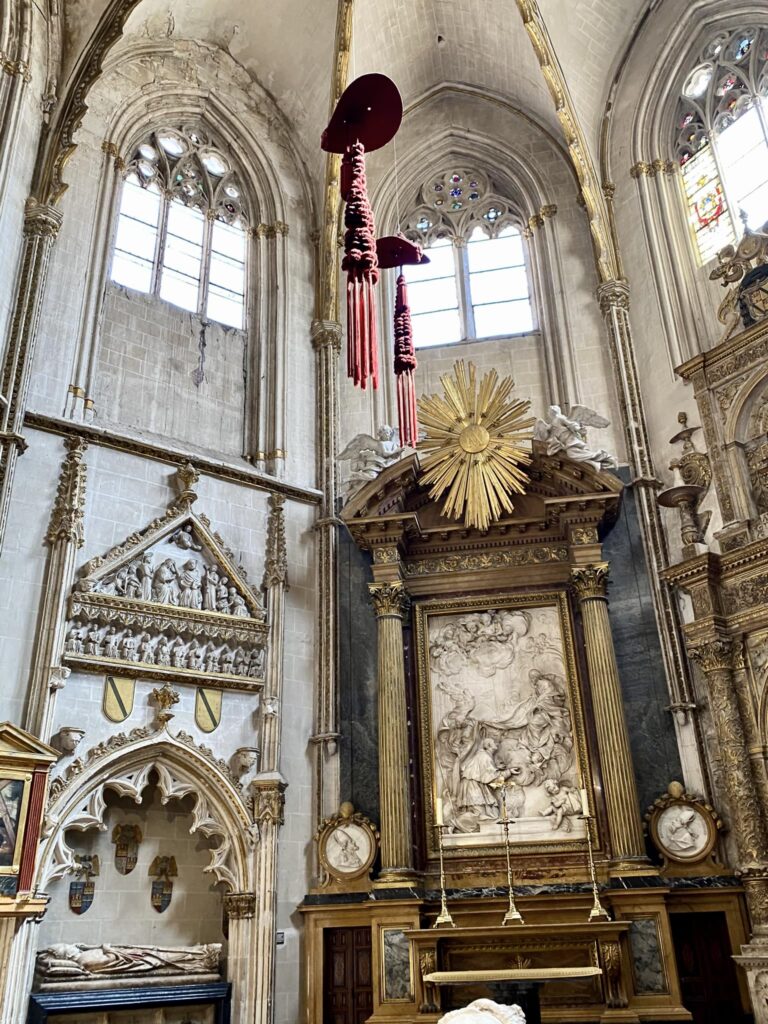
Chapel of St. Idelfonso
The great Chapel of St. Idelfonso is the funery chapel of one of the richest and most powerful families in Castille.
It was commissioned by Gil de Albronoz, Archbishop of Toledo and Cardinal of Spain. Albornoz and much of his family are buried in the side wall niches and underground crypt.
Two cardinal’s hats, known as galeros, hang from the ceiling, indicating a cardinal is buried below. It’s a mark of honor, symbolizing their esteemed position.
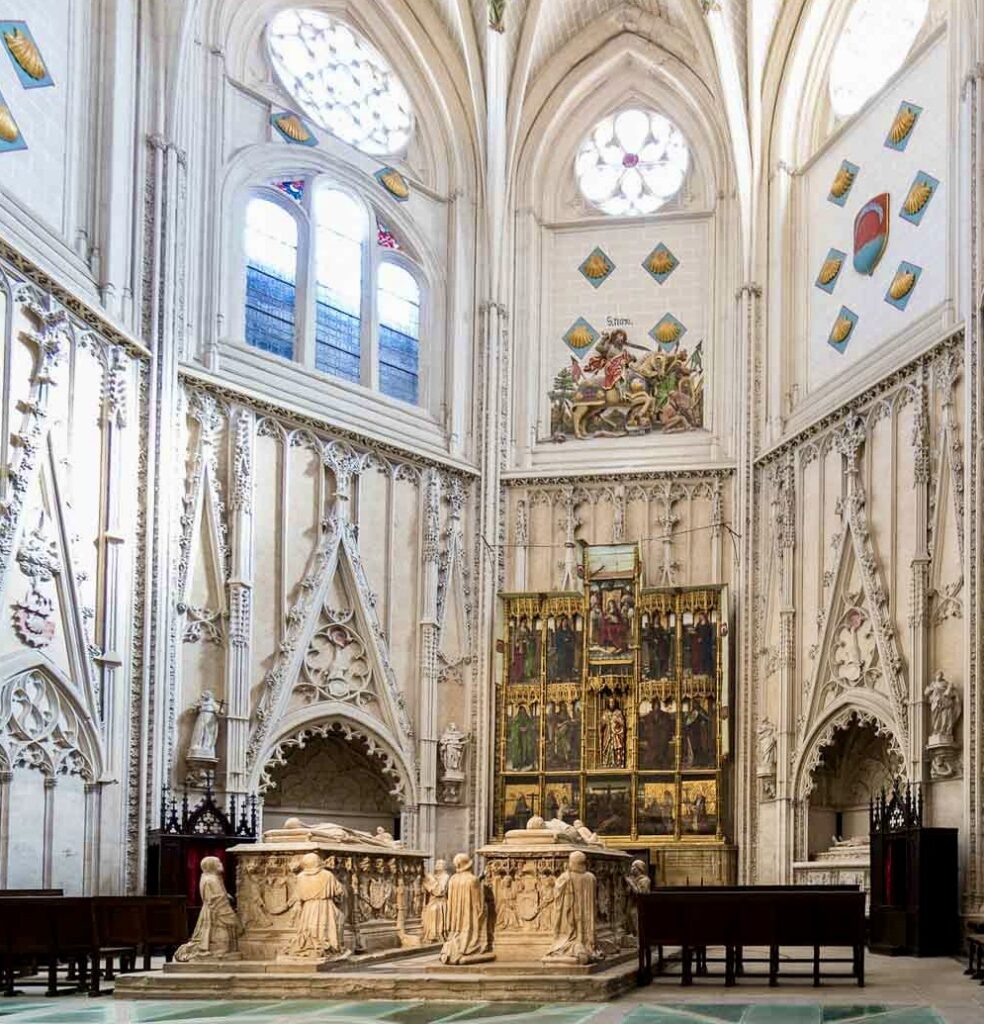
Chapel of St. James
Next door is the chapel of St. James. This is the richest and most luxurious chapel in the cathedral, built in a Flamboyant Gothic style.
Don Albaro de Luna commissioned the chapel in the mid 15th century to be his burial place. Albaro possessed enormous power at the time, and was a favorite of the King of Castille, Isabella’s father.
The central tombs are that of Albaro and his wife. His family is buried in the wall inches.
The Gothic altarpiece is very elaborate. It’s the work of Pedro de Gumiel, with fourteen panels painted by Sancho de Zamora. In the center is the figure of St. James. He’s on horseback killing the Muslims ( a very non PC scene indeed, but historically accurate).
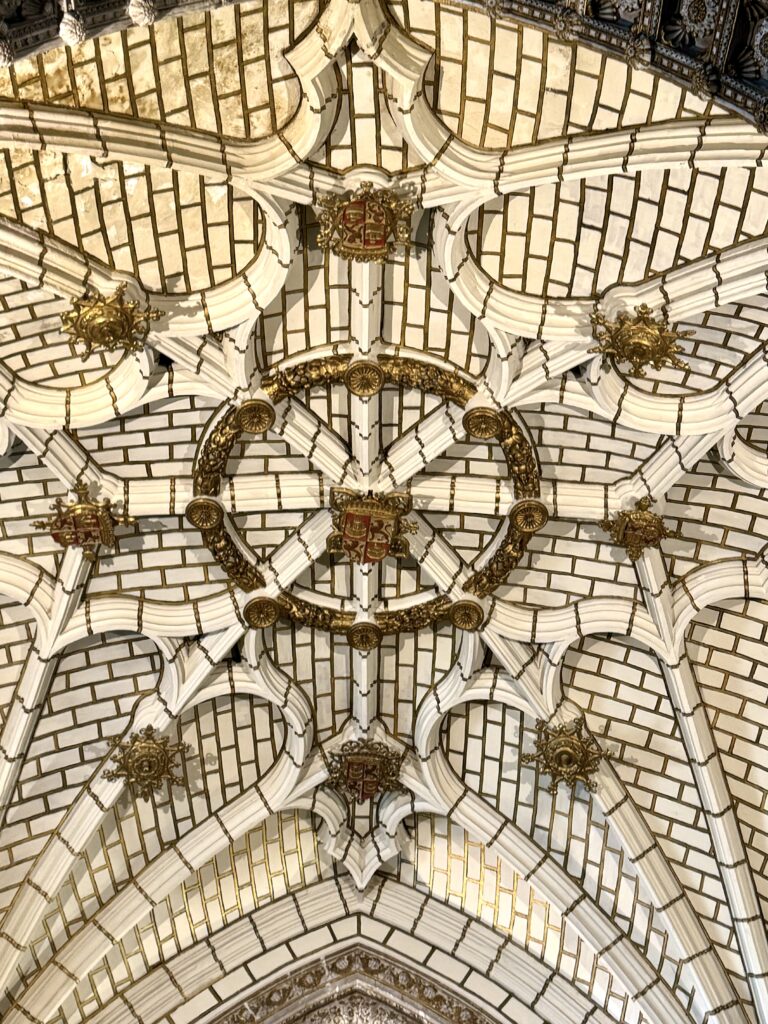
Chapel of the New Kings
This Renaissance style chapel is akin to a mini church. It was commissioned in the mid 16th center by Charles V, grandson of the Catholic monarchs.
It’s the burial place of eight medieval kings of his lineage. Reclining statues mark the tombs. They are depicted in regal attire and surrounded by religious symbols and heraldic motifs.
Among the monarchs buried in the Chapel of the New Kings are King Sancho IV of Castile and his wife Queen María de Molina, as well as their son King Ferdinand IV.
The two sections of the nave have Gothic cross vaults. But all of the ornamentation and carving of the tombs is in Renaissance style.
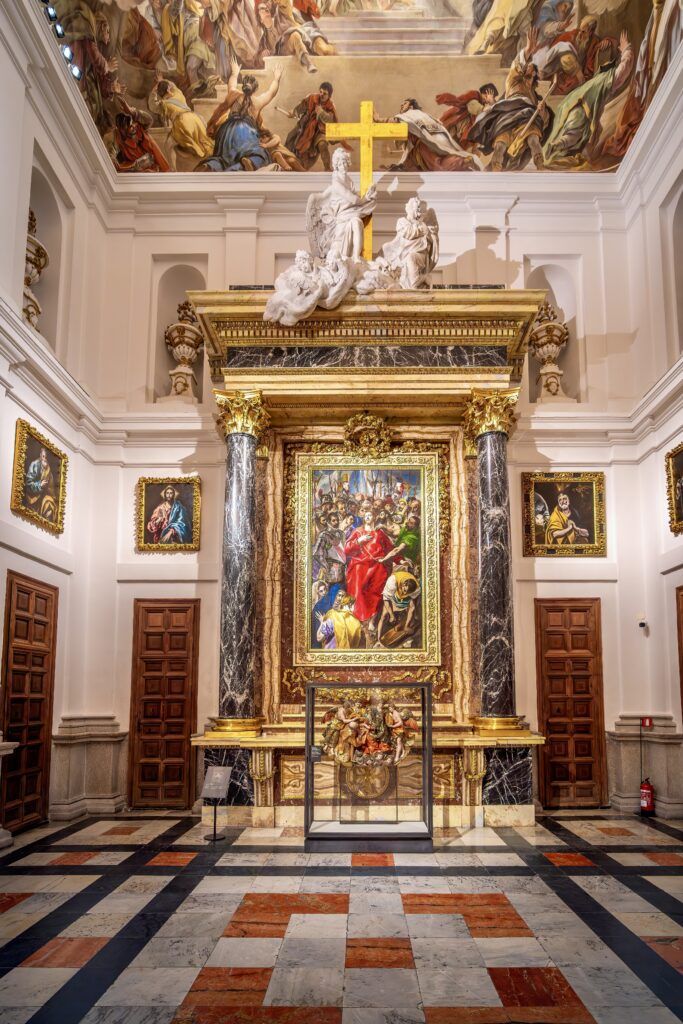
Sacristy
For art lovers, the Sacristy may be the highlight of the cathedral. It was renovated in 2013, giving it an unbeatable new look.
A sacristy is the priest’s locker room. This is where they put on their clerical robes and where objects necessary for religious worship were kept.
This one is a mini-Prado. There are 19 El Greco paintings and works by the likes of Goya, Titian, Velazquez, and Caravaggio. The ceiling fresco is by Luca Giordano and depicts The Descent of the Virgin.
The most important painting in the collection is front and center, El Greco’s The Disrobing of Christ. It was the first masterpiece he painted after arriving in Toledo.
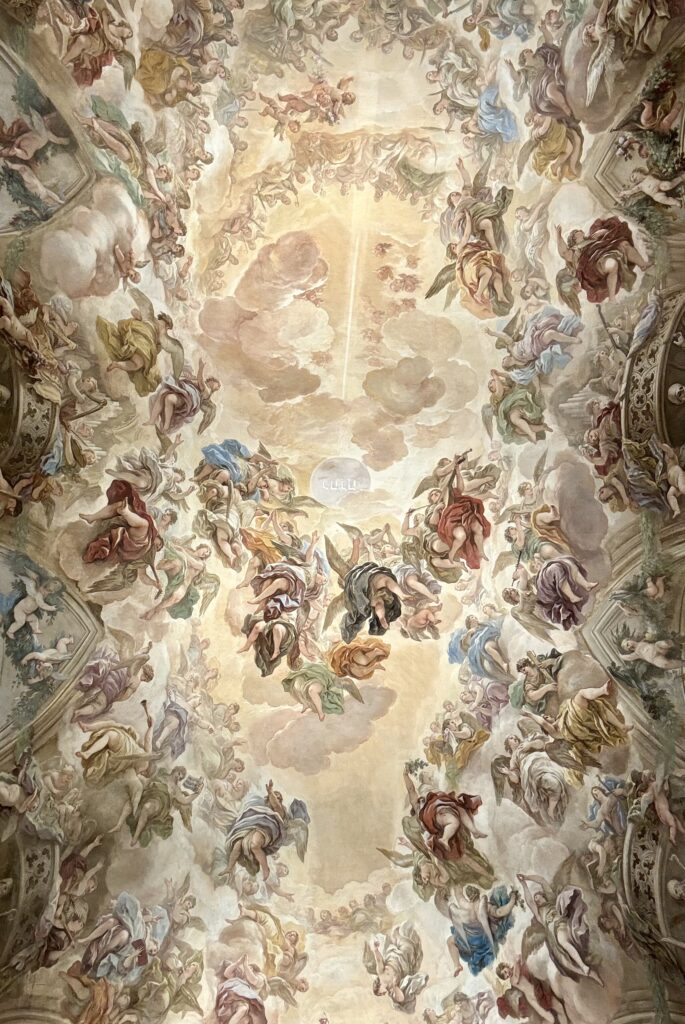
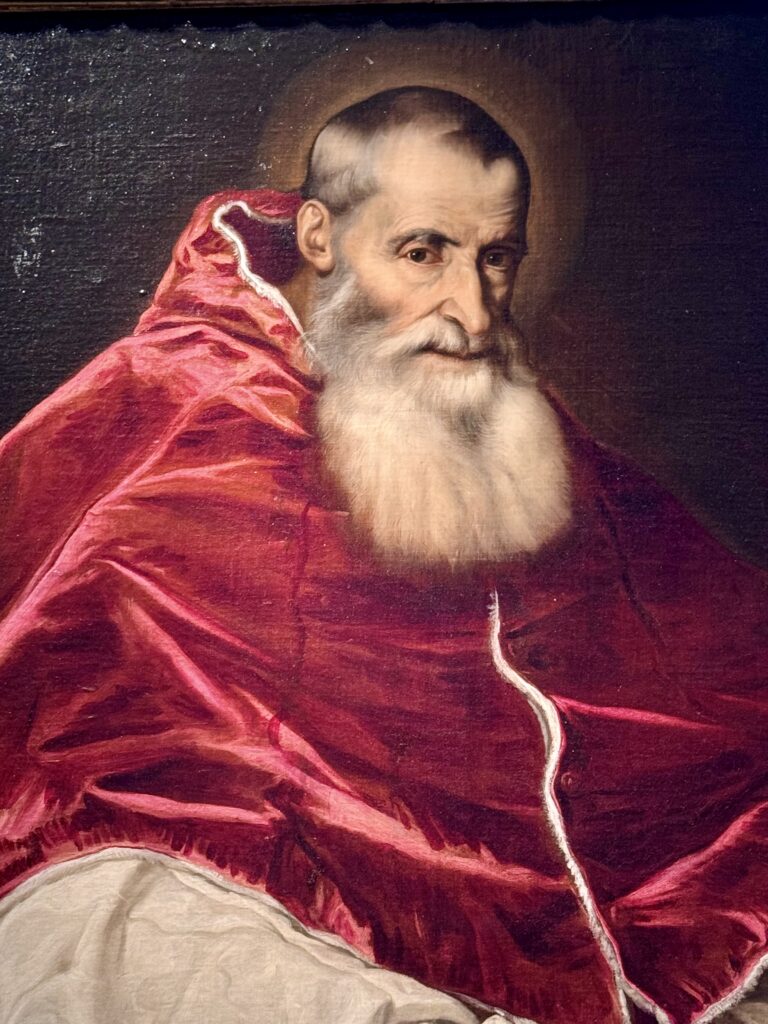
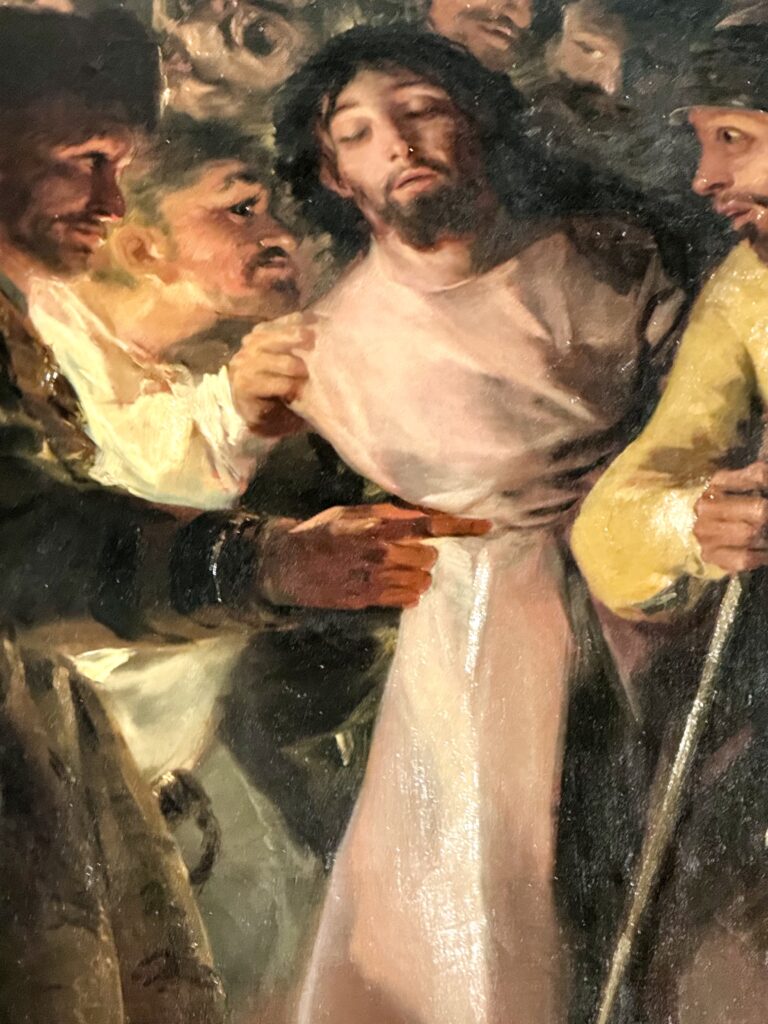
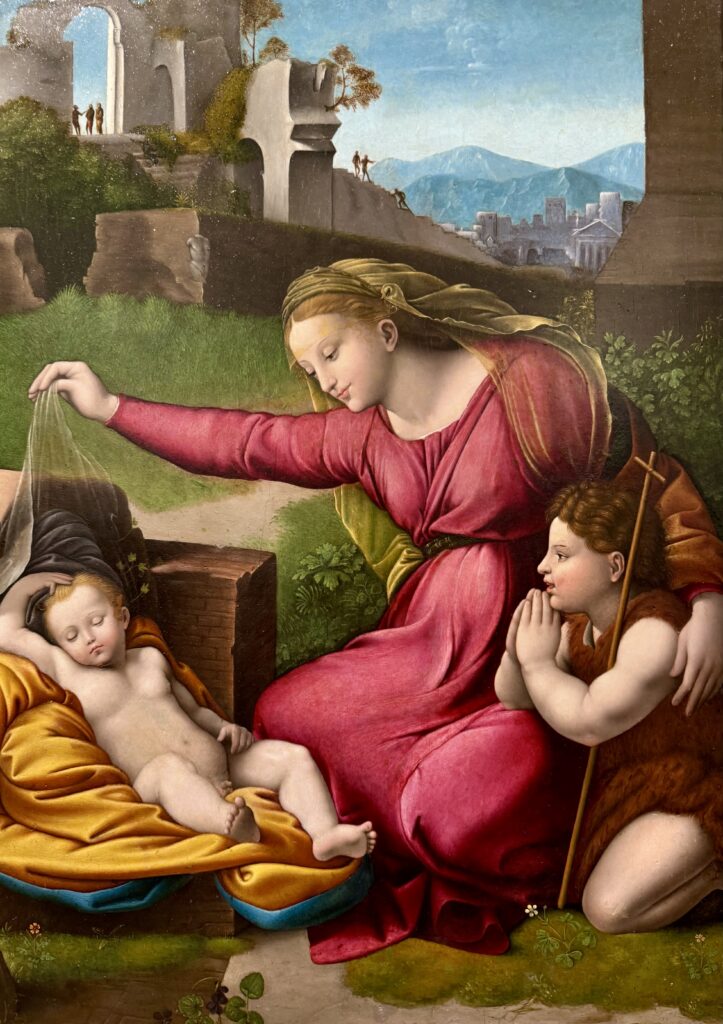
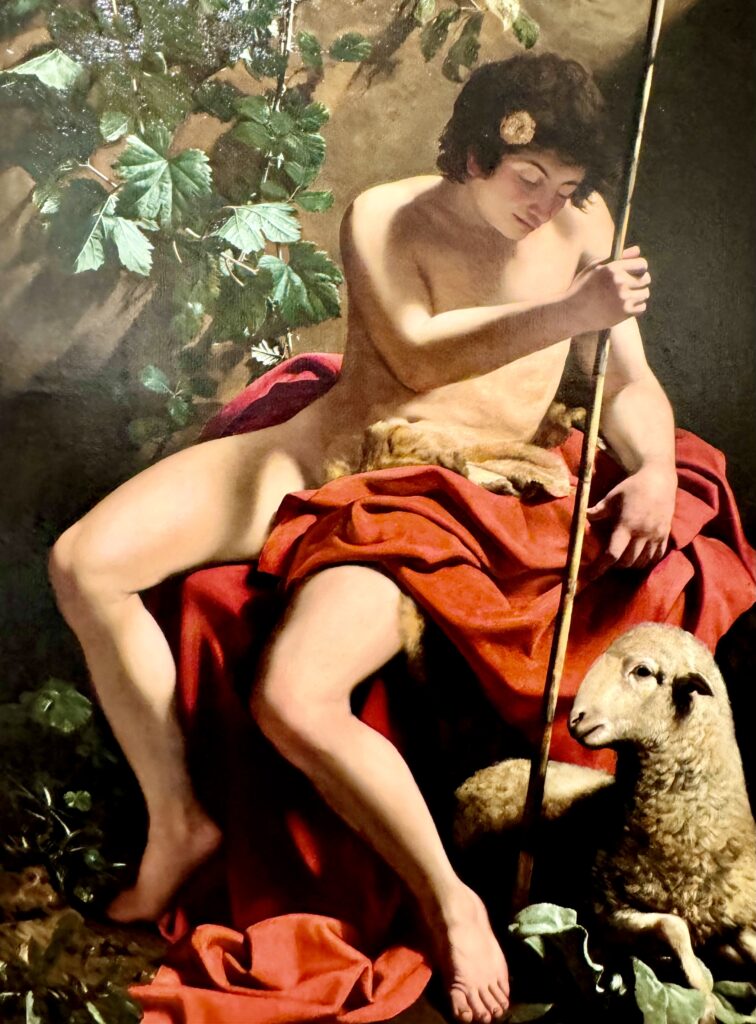
It portrays the moment when Christ is undressed before his crucifixion. He looks dignified, while he endures ignoble treatment from an angry mob.
As in many El Greco paintings, Christ looks like he’s almost levitating. The painting is quite Italian, reflecting El Greco’s stays in Venice and Rome. The bright red robe, a typical Titian color, stands out.
There are other El Grecos adorning the room, including portraits of the apostles.
To the right of the Disrobing is a painting by Goya, the Betrayal of Christ. It shows Judas preparing to kiss Christ, a signal to the Roman soldiers waiting to seize him.
In two adjoining rooms are more masterpieces by artists like Titian, Velazquez, Van Dyke, Raphael, Bellini, Bassano, and Zurburan. Of note is Titian’s probing portrait of Pope Paul III.
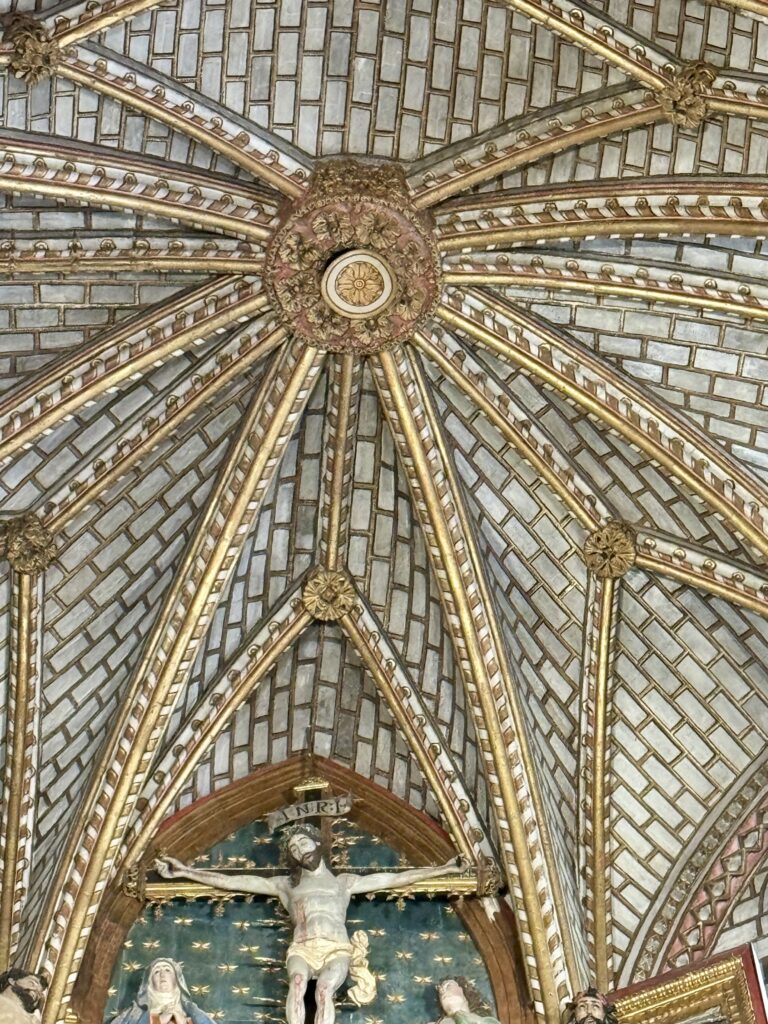
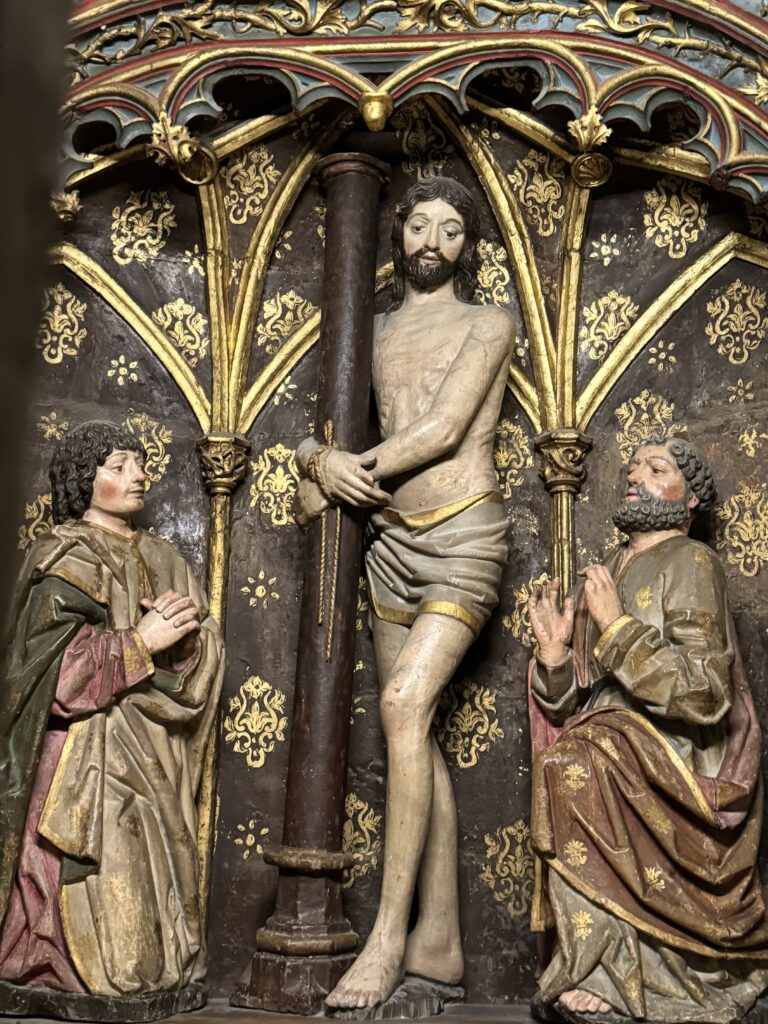
Practical Guide & Tips For Toledo Cathedral
Address: Calle Cardenal Cisneros, 1. The entrance is to the right of the front facade of the cathedral.
Hours: Monday through Saturday from 10:00 am to 6:30 pm. Sundays and holidays from 2:00 pm to 6:30 pm.
Tickets: 12 euros. Tickets are sold in the shop opposite the church entrance. Click here to pre-book a ticket in advance, a good idea in high season.
Pro Tips:
Remember that Toledo Cathedral is a religious site, so dress modestly out of respect. Avoid wearing clothing that exposes shoulders, knees, or midriffs.
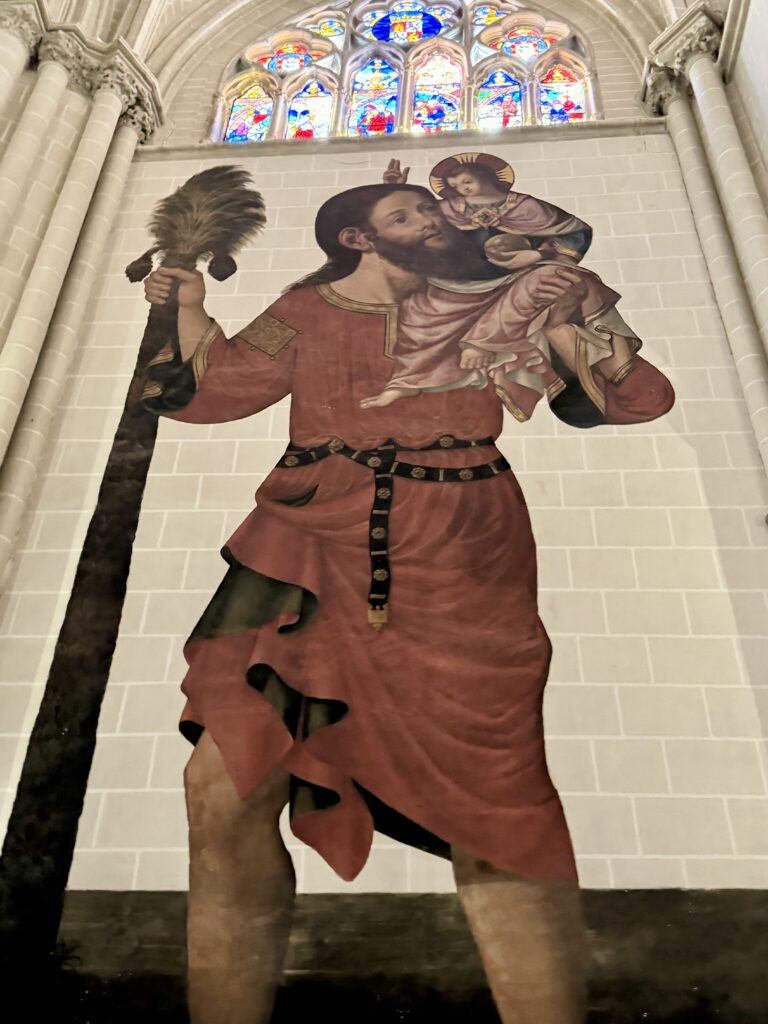
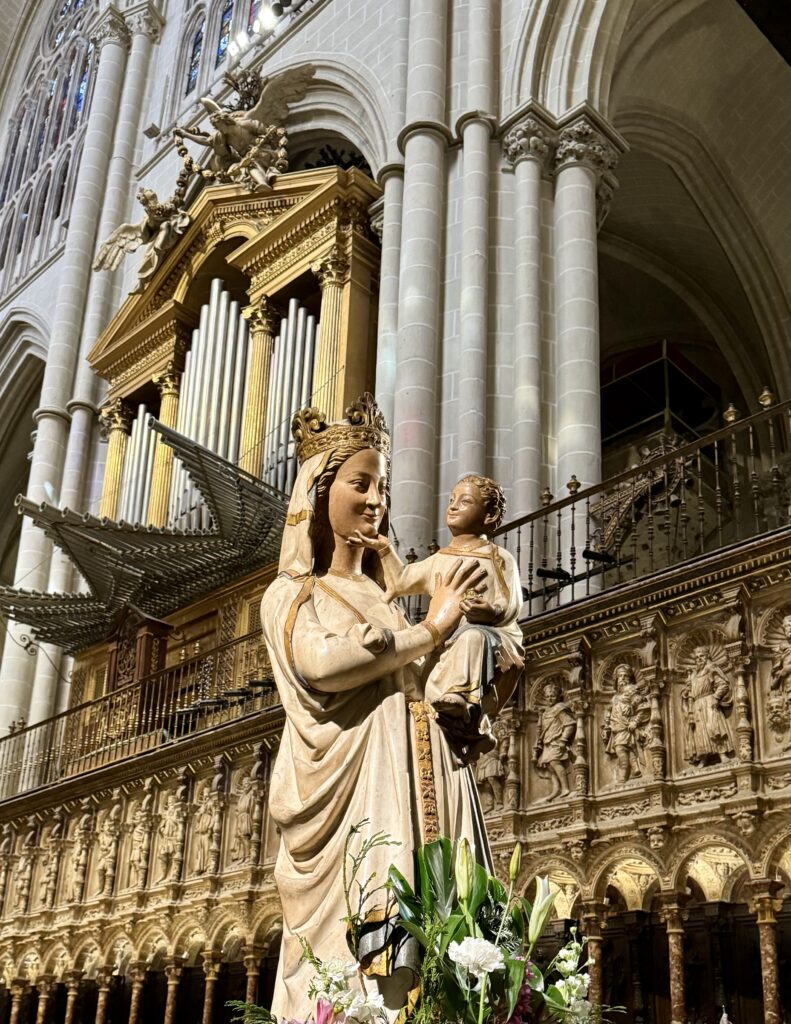
I would budget at least 90 minutes to see everything. 2 hours might be a better estimate, especially if you want to peak at all the chapels.
I hope you’ve enjoyed my guide to Toledo Cathedral. You may enjoy these other Spain travel guides:
- 10-14 days in Spain itinerary
- 3 day itinerary for Barcelona
- 40+ Landmarks in Barcelona
- 33 secret towns in Spain
- 10 day itinerary for Andalusia
- Most Beautiful Towns in Andalusia
- 1 day itinerary for Seville
- 3 day itinerary for Seville
- 2 day itinerary for Madrid
- 2 day Itinerary for Bilbao
Pin it for later.

